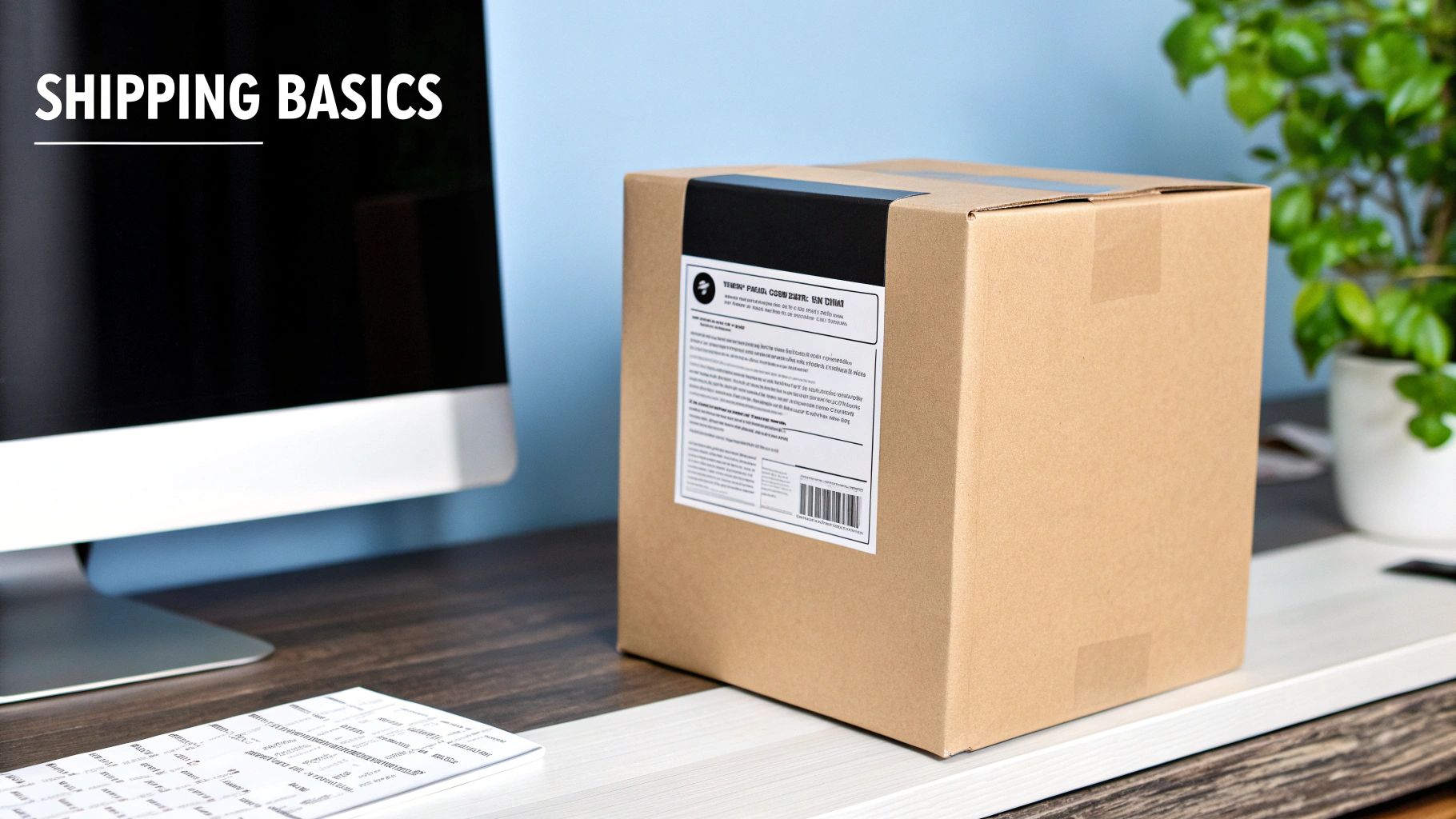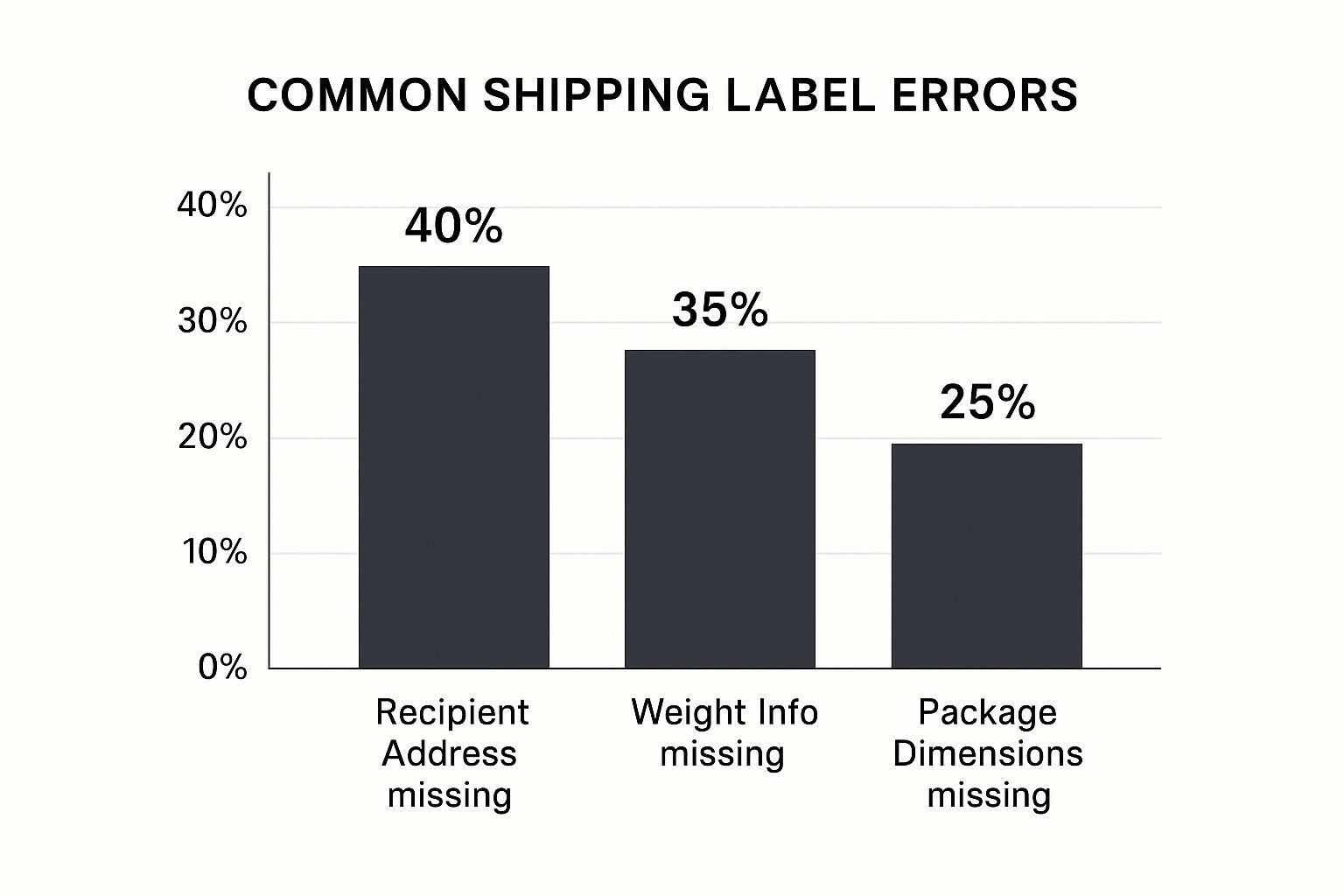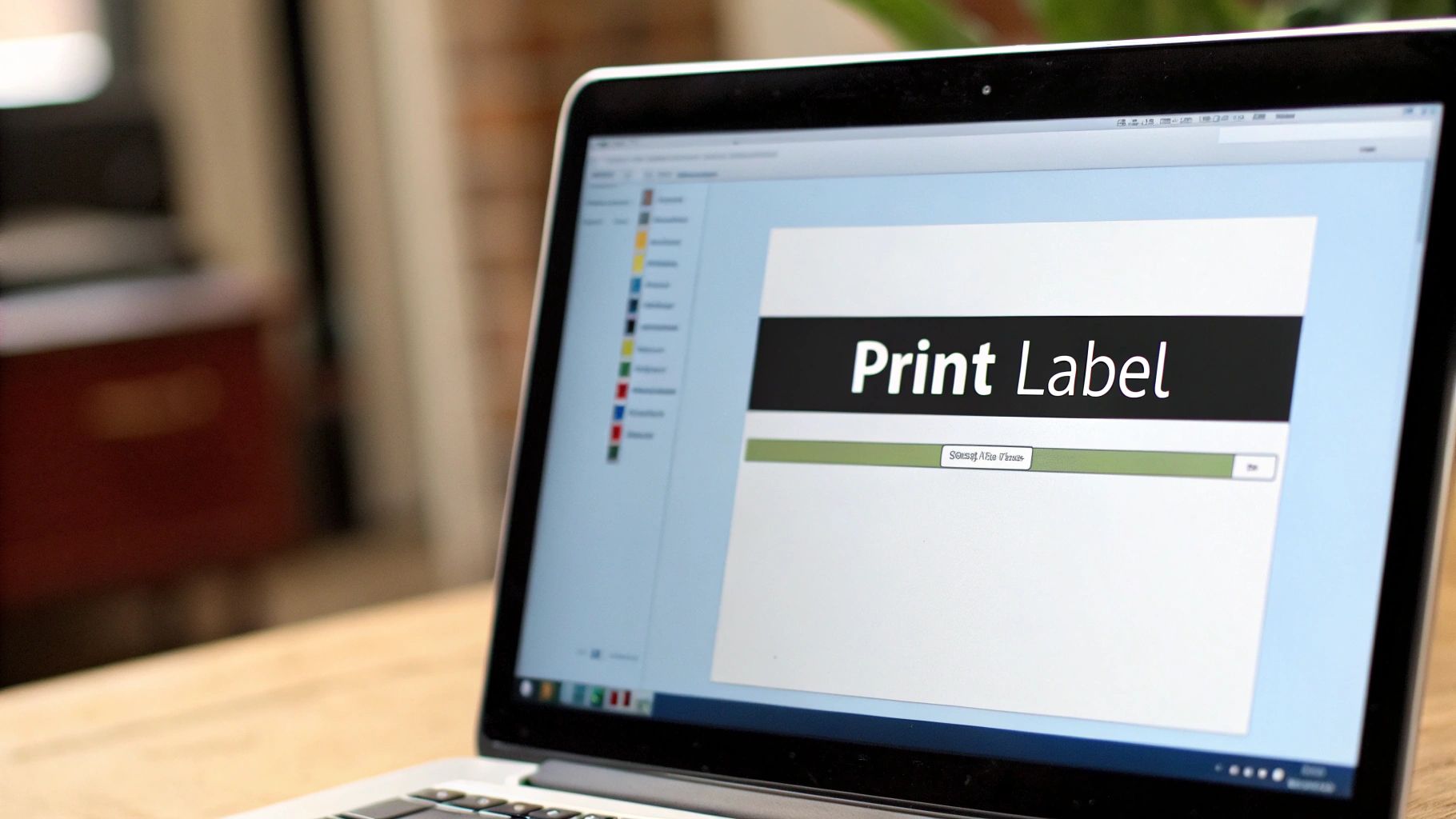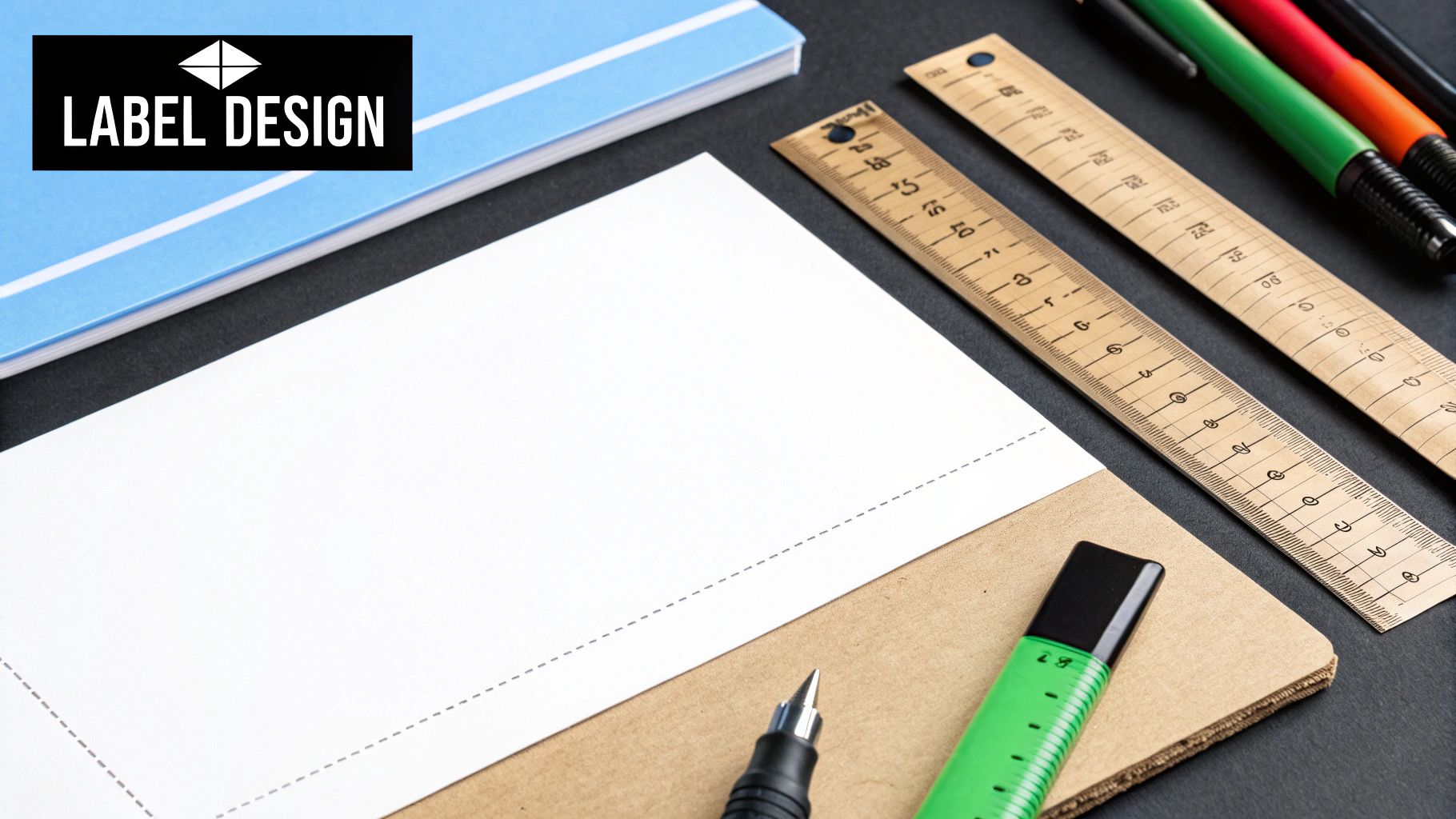To get a shipping label printed correctly, you need two things: a reliable printer and the right software to create the label file. The process itself is simple. You can get started with a standard office printer and A4 paper, or you can go for a dedicated thermal printer with 4×6 inch adhesive labels. The best choice comes down to matching your equipment to your shipping volume to keep things speedy and cost-effective.

Getting your products out the door and to your customers starts with a professional, scannable shipping label. This guide will walk you through the whole process, from picking the right gear to printing your first label from home. A good setup saves you trips to the post office; it also makes your business look sharp and professional.
The decisions you make now will have a real impact on your day-to-day workflow. For instance, the printer you choose will affect not just what you spend upfront, but also your running costs for ink and paper down the line. In the same way, your software choice determines how much time you’ll sink into tedious tasks like manually typing in addresses.
To put together a home shipping station that works for you, you’ll need a few items. When these bits of kit work together, they create a smooth process that cuts down on mistakes and frees up your time.
Here are the basics you’ll need for any setup:
Choosing the right tools from the start is the foundation for an efficient shipping process. A small investment in a thermal printer can save a growing business hundreds of pounds in ink and time over a year.
Think of this as your roadmap for the journey ahead. It lays out the main decision points and gives you the context you need to tackle the more detailed advice that follows. With this foundation, you’ll be able to build a system for printing shipping labels that works for you and your business.
The printer you choose is the engine of your shipping operation. It’s tempting to use your existing office inkjet or laser printer – after all, the upfront cost is zero. But many businesses find this is a false economy, leading to higher costs and major headaches down the line.
If you’re a UK business shipping more than a handful of parcels a week, a dedicated thermal printer isn’t a luxury; it’s a smart investment that pays for itself.
Inkjet printers can be messy. Their ink cartridges are pricey and, worse, the ink can smudge if a parcel gets damp, making your barcodes impossible to scan. Laser printers are a step up in quality, but the toner is still expensive. The adhesive from cheap label sheets can melt and gum up the inside of a laser printer, which is a costly repair. It is no wonder so many growing e-commerce businesses quickly graduate from their standard office printers.
Thermal printers don’t use a single drop of ink or a speck of toner. They use heat to activate a special coating on the label paper, creating a crisp, durable image that won’t run or smudge. This makes them significantly faster and much cheaper to operate.
A small Etsy shop might get by with A4 label sheets at first, but once those orders start rolling in, the time you waste cutting and taping individual labels starts to sting. A Shopify store processing dozens of orders a day needs a thermal printer that can spit out a perfect, self-adhesive 4×6 inch label in seconds. It is a big change for efficiency.
If you’re ready to dig deeper, you can find more detail on specific models in our complete guide to selecting a shipping label printer.
A key takeaway: A thermal printer has a higher initial cost, but the savings on ink or toner alone often pay for the machine within a year. The speed and professional look it adds to your parcels is a massive bonus that customers notice.
The explosive growth of e-commerce has put a spotlight on efficient shipping. Here in the UK, online sales now account for around 30% of all retail, so getting parcels out the door quickly is more critical than ever. It’s a massive market, and having the right tools separates the pros from the amateurs.
To make the decision clearer, let’s break down the main differences between the printer types.
| Printer Type | Best For | Upfront Cost | Ongoing Costs | Print Speed |
|---|---|---|---|---|
| Thermal | High-volume, professional shipping | Medium to High | Very Low (Labels only) | Very Fast |
| Inkjet | Very low-volume, occasional use | Low | High (Ink cartridges) | Slow |
| Laser | Low to medium-volume, multi-use | Medium | Medium (Toner) | Moderate |
For any serious shipping volume, the long-term benefits of a thermal printer are hard to ignore.
The labels you choose are just as crucial as the printer itself. Your choice comes down to two main formats:
Getting the label right is fundamental to avoiding delivery failures. A clear, correctly formatted label is your best defence against common shipping errors.

Simple mistakes like missing address details or incorrect weight information cause 75% of all label-related shipping problems. This shows how accurate data and a clean, scannable printout are.
Once you have your printer sorted, the next piece of the puzzle is the software you’ll use to create your shipping labels. This is just as important as the printer itself. The right software does so much more than just slap an address on a sticker; it’s the brain of your shipping operation, connecting everything together, catching mistakes, and often saving you a decent chunk of cash on postage.
What works for you will come down to how many parcels you’re sending out and where you’re selling your products.
If you’re just starting out or only ship a few items a week, you don’t need to overcomplicate things. Heading directly to your courier’s website, like Royal Mail’s Click & Drop, is a perfectly good place to start. You’ll have to type in the address details manually and pay for postage one parcel at a time, but it’s free and does the job without any fuss.
When you hit that point where manually typing addresses feels like a full-time job, it is time to upgrade. This is where proper shipping software or the tools built into your e-commerce platform become absolute necessities.

One of the most powerful features of dedicated software is courier rate shopping. It automatically compares prices across different couriers for every single parcel. You’ll instantly see the cheapest or fastest option without having to check multiple websites yourself.
The goal is to find a system that slots right into your existing process. This is especially true if you’ve invested in a thermal printer; getting the software right is what unlocks its full potential. You can learn more about how a thermal label printer for shipping and the right software create a seriously efficient setup.
This integration is what turns shipping from a time-consuming chore into a fast, almost automatic, part of your day. It eliminates copy-and-paste errors, gets orders out the door faster, and gives your customers a professional experience with accurate, easy-to-track shipping.
You’ve got your printer and software sorted. Now for the satisfying part: printing the shipping labels for your parcels. What might seem a bit daunting at first is just a few simple clicks. Let’s walk through turning those order details into a professional, courier-ready label.
You will first plug in the recipient’s address and the package details. Let me be clear: accuracy here is everything. Always double-check postcodes. I also can’t stress enough the importance of using a digital scale to get the exact weight. Guessing is a surefire way to get hit with unexpected surcharges from your courier later on.
Once you’ve entered the address and your package specifics (like its weight and dimensions), your shipping software will lay out all the available service options. This is where you’ll pick your courier and the type of service you need – think Royal Mail Tracked 48 or a guaranteed next-day delivery. After you’ve made your choice, you simply pay for the postage right there on the platform.
Here’s a typical screen you might see on a platform like Royal Mail’s Click & Drop, where you input all the order details in one go.
It cleanly lays out the fields for the address, package weight, and service selection, making the whole process straightforward.
The demand for reliable labelling isn’t just a small business concern; it reflects a much bigger picture in UK industry. With UK manufacturers’ product sales recently reaching an estimated £456.1 billion – a 3.9% increase in just one year – the need for clear, accurate shipping labels has never been higher. This industrial growth is what drives the logistics that get those products to customers.
A Quick Tip: Take a moment to understand what’s on the label you’ve just printed. That big barcode is for depot scanners, the tracking number is for you and your customer to follow the journey, and the service type (e.g., “Tracked 24”) tells postal workers exactly how to handle the parcel.
Getting these labels right is a fundamental skill for any seller. If you want to dive deeper into what makes a label truly effective and easy to read, our guide on how to create effective labels is a great resource. Paying attention to these small details is what ensures your packages glide through the delivery network and land safely with your customers.

Even with the best equipment, you’re bound to hit a printing snag eventually. It’s a familiar story: labels come out misaligned, text is inexplicably tiny, or you get a barcode that looks perfect but stubbornly refuses to scan. These moments are frustrating, but the good news is that most of these problems have simple fixes that don’t require calling in an IT expert.
More often than not, the root cause is miscalibration. If your thermal printer suddenly starts printing across the gap between two labels or leaving a massive blank space before the next one, it’s lost its bearings. It needs to be recalibrated. This usually involves holding down a button while the printer feeds a few labels through to relearn the label size and spacing.
Another frequent issue stems from the print settings in your browser or software. If you find your labels are printing out in miniature, the first thing to check is the scale setting in your print preview. It must be set to 100%. Any other value will shrink or stretch the entire label, which can make the barcode completely unscannable.
What if the barcode scans fine on your phone but fails at the Post Office? This is almost always a resolution issue. Look in your settings and make sure the print quality is cranked up to its highest setting. A low-resolution print creates slightly fuzzy or blurred lines that are good enough for a phone camera but will confuse a professional-grade scanner.
A correctly printed shipping label is more than a convenience; in many sectors, it’s a regulatory requirement. In the UK food and pharmaceutical industries, precise labels are mandatory for tracking and safety compliance.
This need for accuracy is a big reason the shipping label market continues to expand. In the UK, strict regulations for critical sectors like food and pharmaceuticals drive the demand for specialised labels that must include batch numbers and other crucial data, as detailed in this report on the shipping label market.
Fixing these small issues as they pop up is the secret to keeping your entire shipping operation running smoothly. For a more in-depth look at refining your system from start to finish, you might find our guide on how to optimise labelling processes helpful.
Even the most straightforward process can throw up a few questions once you get started. We hear from UK businesses all the time, so we’ve put together some quick answers to the most common queries we see when it comes to printing shipping labels.
Yes. You can print a shipping label on a normal piece of A4 paper with any standard office printer. Once it’s printed, you’ll need to carefully cut it out and stick it to your parcel.
The best way to attach it is with clear packing tape, but be careful. Make sure the tape doesn’t cover any barcodes or address details, as the reflection can sometimes prevent scanners from reading them properly. This method works fine if you’re sending the odd parcel, but it’s not a great long-term solution for a business. It’s slow, fiddly, and doesn’t give the most professional impression. If you’re shipping regularly, switching to self-adhesive labels or a proper thermal printer will make your life much easier.
The go-to size for shipping labels in the UK is 4 x 6 inches (roughly 100mm x 150mm). This is the standard used by all major couriers, including Royal Mail, DPD, and Evri.
This size became the industry standard for a good reason. It’s large enough to clearly display everything that matters- sender and recipient addresses, a big scannable barcode, the tracking number, and service details- without everything feeling crammed together. You’ll find that most thermal printers and shipping software in the UK are set up for this size by default.
No, you don’t need a special printer to get started. Your inkjet or laser printer will work perfectly well, especially if you’re printing on A4 paper or specialist adhesive sheets.
If you find yourself shipping more than just a handful of parcels each week, investing in a dedicated thermal label printer is a good move. These printers use heat to create the text and images, so they don’t require any ink or toner at all. That single difference will slash your ongoing costs. On top of that, they’re much faster and produce durable, smudge-proof labels, making your entire dispatch process quicker and more dependable.
For industrial labelling needs beyond shipping, Sessions UK provides a full range of manual, semi-automatic, and fully automatic labelling machinery. Find the perfect solution for your production line.
Copyright © 2025 Sessions Label Solutions Ltd.